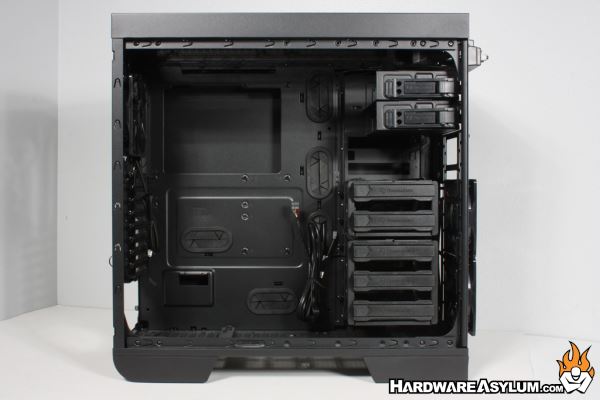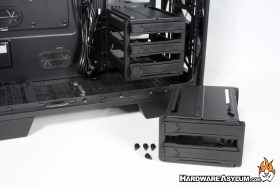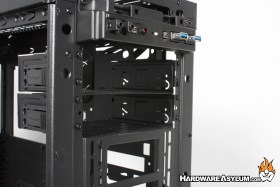Thermaltake Core V51 Case Review
Author: Dennis GarciaCase Layout and Features Continued
We mentioned how the Core V51 was rather conservative in its design and if the outward appearance wasn’t enough then pulling the side panel should drive the idea home. Two external 5.25” drive bays are located at the top of the case followed by five tray mounted 3.5” internal bays towards the bottom.

To the left is the motherboard location with an extremely large opening for motherboard access and quick heatsink swaps. You will find five cable routing holes with grommets to make them look pretty. An interesting thing to note is that one of the holes directly above the PSU location is technically under the expansion slots on a standard ATX motherboard reaffirming that MicroATX and MiniITX motherboards are a welcome addition.
An important feature to note is that all of the interior drive cages are held in place with screws making them easy to remove and/or reposition. There is a fair amount of work involved but the process goes rather quickly.
Due to the nature of an external drive bay and the physical opening on the front bezel the drive cages are usually a permanent part of the chassis but on the Core V51 you will find four screws holding each drive cage in place. This allows you the ability to choose how many bays you need and free up the remainder of the space for cooling gear or just open airspace.
The rest of the case construction is adequate with genuine attempts to make the thin metal panels self supporting to prevent rattles. Each of the case corners has been reinforced with metal corner chunks to both make the corner stronger and dress up the location a little.
All of the metal folds are accurate with no sharp edges. Of course that last statement goes without saying since there hasn’t been a “death case” on the market for many years. ![]()



